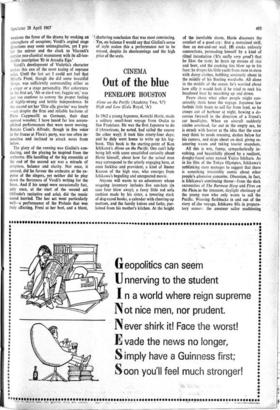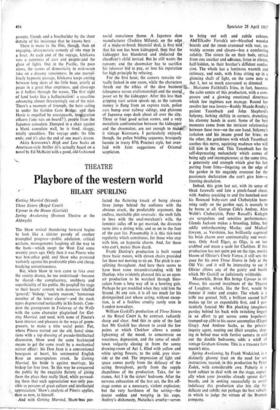CINEMA
Out of the blue
PENELOPE HOUSTON
Alone otz the Pacific (Academy Two, 'U') High and Low (Gala Royal, 'A') In 1962 a young Japanese, Kenichi Hone, made a solitary small-boat voyage from Osaka to San Francisco. He was the first Japanese to do it (Americans, he noted, had sailed the course the other way); it took him ninety-four days; and he duly went home to write up his log- book. This book is the starting-point of Kon Ichikawa's Alone on the Pacific. One can't help being left with some unsatisfied curiosity about Honk himself, about how far the actual man may correspond to the utterly engaging hero, at once feckless and provident, a kind of Buster Keaton of the high seas, who emerges from Ichikawa's beguiling and unexpected movie.
Anyone will warm to an .adventurer whose seagoing inventory includes five sun-hats (in case four blow away), a fussy little red sofa cushion made by his sister, a towering stack of dog-eared books, a calendar with cheering-up mottoes, and the family knives and forks, pur- loined from his mother's kitchen. At the height
of the inevitable storm, Horse discovers the comfort of a good cry : first a restrained sniff, then an out-and-out wail. He cooks unlovely concoctions, persuading himself by a kind of ritual incantation (It's really very good') that he likes the taste; he heats up messes of rice and beer, and the cooking tins blow up in his face; he drapes his little yacht from stem to stern with damp clothes, bobbing anxiously about in the middle of his floating wardrobe. All alone in the middle of the ocean, he's worried about how silly it would look if he tried to rock his becalmed boat by marching up and down.
Fears about what other people might con- ceivably think beset the voyage. Japanese law forbids little boats to sail far from land, so he creeps out of harbour at night, bowing a de- corous farewell in the direction of a friend's car headlights. When an aircraft suddenly circles overhead, far out in the empty sea, he is struck with horror at the idea that the crew may think he needs rescuing, dashes below for his camera, and skips about on deck giving re- assuring waves and taking tourist snapshots.
All this is wry, funny, sympathetically in- volving, and beautifully played by a resilient, doughy-faced actor named Yujiro Ishihara. As in his film of the Tokyo Olympics, Ichikawa's unblinking stare manages to suggest that there is something irresistibly comic about other people's _obsessive concerns. Obsession, in fact, is Ichikawa's continuing theme—from the dark extremities of The Burmese Harp and Fires on the Plain to the innocent, daylight obstinacy of the young man who only wants to sail the Pacific. Weaving flashbacks in and out of the story of ,the voyage, khikawa fills in prepara- tory scenes: the amateur sailor maddening parents, friends and a boatbuilder by the sheer density of his insistence that he knows best. , ...
There is more to the film, though, than an engaging, idiosyncratic comedy of one man in a boat. At each end of the voyage, Ichikawa sees a sameness of cars and people and the glare of lights. Out in the Pacific, the pace slows, the scenes of domesticity in mid-ocean take on a dreamy remoteness. In one marvel- lously hypnotic passage, Ichikawa keeps cutting between long shots of the little boat, utterly at peace in a great blue emptiness, and' close-ups as it buffets through the waves.. The first sight of land looks like a hallucination: a coastline advancing almost threateningly out of the mist. There's a moment of triumph, the hero sailing in under the Golden Gate Bridge; aid then Hone is engulfed by coastguards, int gration officers early rats on board?'), people rom the Japanese consulate. Dumped in a chair against a blank consulate wall, he is tired, shaggy, totally speechless. The voyage ends; the film ends; and it's also the end of one man's dream.
Akira Kurosawa's High and Low backs an American-style thriller (it's actually, based on a novel by Ed McBain) with a good, old-fashioned social conscience theme. A Japanese shoe manufacturer (Toshfro Miltine), on the edge o a niake-or-break fifianciafdeal, is first --Col< that his son has been kidnapped, thin that the kidnapper has blundered and abdticted the' chauffeur's child instead. But he still 'wants the' ransom; and the shoemaker has to sacrifice his takeover bid to pay, or lose his reputation for high principle by refusing.
For the first hour, the camera remains vir- tually locked in one room, while the characters thrash out the ethics of the shoe business (cheapness versus craftsmanship) and the moral., poser set by the kidnapper. After this less than gripping start action speeds up, as the ransom money is flung from an express train, police cars bump over railway sidings, and platoons of Japanese cops dash about all over the city. Three or fur good action scenes, and a very moralistic confrontation between the kidnapper and- the shoemaker, are not enough to znakir:.- it vintage Kurosawa. I particularly enjoyed, though, the police briefing sequence, brusquely laconic in trusty 87th Precinct style, but over- laid with faint suggestions of Oriental scepticism.







































 Previous page
Previous page